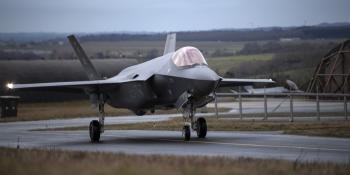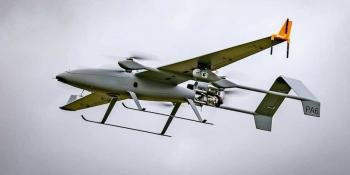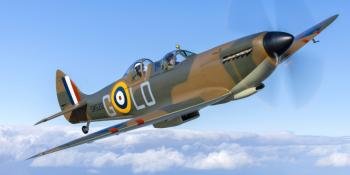Boeing is on course to deliver a new unmanned aerial system (UAS) to the US Navy that boasts two world firsts. The MQ-25A Stingray will be the first UAS designed with an air-to-air refuelling capability and the first operational carrier-based fixed-wing unmanned aircraft. Khalem Chapman explores the programme and investigates the industry team that created the MQ-25A.

Boeing’s MQ-25 Stingray was launched under Naval Air Systems Command’s (NAVAIR’s) Carrier-Based Aerial-Refueling System (CBARS) programme, with a request for proposals (RFP) being answered by four companies. Boeing, Lockheed Martin, General Atomics (GA-ASI) and Northrop Grumman all sought to provide the US Navy with an eff ective, aff ordable, sustainable and adaptable unmanned tanker to exponentially increase the capabilities of Carrier Air Wings (CVWs) deployed at sea. Prior to the contract being awarded, the US Navy ceased referring to the programme as CBARS, opting to call it the MQ-25 programme instead.
Despite successfully completing a raft of pioneering tests with its X-47B, Northrop Grumman dropped out of the competition, citing its inability to carry on with the programme under the US Navy’s RFP proposals. Boeing was awarded an US$805m contract in August 2018 for the design, development, fabrication, test, delivery and support of four engineering and manufacturing development (EMD) aircraft. It incorporated CVW integration for an initial operational capability (IOC) by 2024, with the Navy’s Unmanned Carrier Aviation Program Off ice (PMA-268) handling the MQ-25A – in what is its first such air system procurement for NAVAIR.

The MQ-25 programme only really became headline news in 2016, originating from the ambitious Unmanned Carrier-Launched Airborne Surveillance and Strike (UCLASS) programme. The programme was simplified to concentrate on an unmanned tanker to make CVW strike fighters more effective, extending the aircraft’s range by 300-400 miles (482-643km) and allowing carrier strike groups to operate at farther, safer distances from combat areas. It will additionally provide the overhead safety of an organic tanker, able to replenish returning aircraft in the case of a foul deck or in poor weather when fuel states may be low, and additional holding fuel may be required. In addition, the MQ-25A will offer the navy a basic intelligence, surveillance and reconnaissance (ISR) mission.
Progress on the MQ-25 progressed rapidly, with a request for proposal (RFP) and choice of platform being made in just over two years from the programme’s formal announcement, followed by the Stingray’s first flight last September, almost a year later. However, there’s much more than just aircraft development to consider with this project, as PMA-268 split the contract into three architectural segments, with the navy as the lead systems integrator.
The first handles the air side of the contract, which produces the MQ-25A itself, alongside associated support, handling equipment and aircraft spares. The second covers the Stingray’s Control System and Connectivity (CS&C), providing the Unmanned Carrier Aviation Mission Control System (UMCS), along with Distributed Common Ground Station-Navy (DCGS-N) mission intelligence support functionality, network-based interfaces, routing and communication equipment plus additional modifications to existing C4I system infrastructure and networks. The third segment deals with the US Navy’s nuclear-powered aircraft carriers (CVNs), the handling space allocation for the aircraft within an already packed air wing, associated data dissemination kits (such as antennas and radio terminals), aircraft launch/recovery and deck operation systems. All of this is alongside the installation of necessary air and CS&C systems from the first two segments.

Taking the Stingray to Sea
The US Navy announced in mid-2017 that the first two CVNs to undergo MQ-25A control station and system integration will be the USS Dwight D Eisenhower (CVN 69) and the USS George H W Bush (CVN 77).
Boeing’s MQ-25A Stingray test asset, T1 (registration N234MQ), first flew in September 2019– operating from MidAmerica St Louis Airport, Mascoutah, Illinois. The aircraft was flown by test pilots from a ground control station at the airport. T1 successfully completed an autonomous taxi and take-off, flying for two hours along a pre-determined route in which pilots tested the aircraft’s basic flight functions and its operations with the ground control station.
In total, NAVAIR plans to acquire 72 MQ-25A Stingrays in a deal which could potentially be worth $13bn. This inventory could complement CVWs with between two and four aircraft for each of the service’s 11 carrier strike groups, leaving enough aircraft for domestic land-based training. In 2017, the US Government Accountability Office (GAO) issued a report which stated that the US Navy sought to invest almost $2. 5bn into the MQ-25A programme during fiscal year 2022 (FY2022), with expectations that development costs will not exceed $5 billion.

MQ-25 Industrial Team
Despite Boeing receiving the NAVAIR contract to produce the MQ-25A Stingray, it is not a project which the company achieved alone. As with many aircraft development programmes – both civil and military – there is a now large amount of supply chain co-operation among aerospace companies, working together to produce the aircraft.
There are roughly 20 major subcontractors that Boeing – the prime contractor – is working with in order to realise the MQ-25A, all delivering different systems, parts or computers for the platform. Aitech Defense Systems (ADS) is providing the aircraft’s key mission interface systems after being contracted by Boeing in May 2019. ADS will be contributing an advanced remote input/output (I/O) interface controller, customised for the Stingray, but based on its commercial-off-the-shelf (COTS) Ai-RIO Small Form-Factor Remote I/O Subsystem, which is designed for application in military aerospace or alternatively for use in low-earth-orbit. Ai-RIO is used in a number of different ways when integrated into a platform that includes flight, attitude and navigation control; video and image processing and storage; servo-valve and thrust vector control; high speed data recording; communications and telematics; and also robotic motor control – to name just a few.
BAE Systems announced a contract from Boeing in June 2019 to supply the MQ-25A’s Vehicle Management Control System (VMCS) and Identification Friend or Foe (IFF). The former will perform overall vehicle management duties as well as control all the aircraft’s flight surfaces. The latter ensures that the MQ-25A can successfully operate in contested environments, giving it the ability to reliably identify hostile and coalition vehicles.

Cobham Aerospace has been associated with the CBARS programme for some time, with NAVAIR’s RFI detailing the requirement for proposed platforms to be able to equip two externally mounted hose and drogue-style air-to-air refuelling pods, with one located underneath each of the aircraft’s wings. Despite the RFI citing a need for two pods, a Boeing official has since confirmed that the Stingray will only have the one. The MQ-25A will either be equipped with Cobham’s 28-300 or 31-301 buddy stores series, both of which are used by US Navy F/A-18E/F Super Hornets for aerial ‘buddy-buddy’ refuelling where two of the same aircraft, typically fighters, are equipped with a small pod to refuel each other.
This is a system that has been adopted more by naval than generic air forces due to the lack of a tanker aircraft presence, something that will change following the Stingray’s introduction. Cobham’s 28-300 and 31-301 buddy stores series both have a fuel capacity of 300 US/gal (1,363. 83 lit) capable of pumping fuel to a receiving aircraft at a rate of 220 US/gal (1,000. 14 lit) per minute. Both pods are mounted on an aircraft’s ejector rack and, in use, the devices are powered by a ram air turbine which drives a variable displacement hydraulic pump, moving the hose reel and activating the fuel pump motors.
Rolls-Royce is supplying its AE 3007N turbofan for the MQ-25A Stingray, a newer version of an engine already in use in the US Navy, the powerplant of the Northrop Grumman MQ-4C Triton high-altitude, long-endurance (HALE) UAS – along with its US Air Force counterpart, the RQ-4A Global Hawk. The MQ-25A will be driven by a single AE 3007N, which is rated to deliver more than 10,000lbs of thrust and provides additional electrical power. The Triton, with a maximum thrust rate set at just under 9,000lbs, gives it a top speed of 357mph (575km/h or Mach 0. 46). With more than 10,000lbs provided by the AE 3007N, the MQ-25A could have a top speed of around 537mph (864km/h or Mach 0. 70) or more, depending on how much more thrust the engine produces above 10,000lbs.

The MQ-25A’s brake control system and associated components are being provided by Crane Aerospace & Electronics; a company known for its Landing Gear Control Interface Unit employed on Airbus’ A320-family aircraft. Cubic Mission Solutions was contracted by Boeing in April 2019 to provide the Wideband Satellite Communications (SATCOM) modem system and Line-of-Sight (LOS) Common Data Link (CDL) kit for the Stingray. The platform’s data technology systems will come from Curtiss-Wright Defense Solutions and GE Aviation will supply a stores management solution for the MQ-25A, which includes a comprehensive safety architecture for a variety of stores and refuelling systems.
Frequentis Defense has been contracted by the US Navy – not Boeing – to provide IP-based voice communications for the MD-5A UMCS with the CS&C segment of the Stingray’s development contract. The Naval Air Warfare Center’s Aircraft Division (NAWCAD) posted an RFI in late 2017, which outlined the MD-5 UMCS and its operational duties. It says the MD-5 will be split into two separate variants – the carrier-based MD-5A and the land-based MD-5B – thus enabling the Stingray to be operated both from a carrier and from a shore base. Having two separate control stations with one based on carriers makes it easier for pilots to fly the MQ-25A from a CVN; this is due to the increased situational awareness they would have over land-based UAS operators as, when deployed, it’ll be easier for Stingray pilots to factor in the mission outline and the weather more effectively, with the latter able to change frequently and, at times, instantaneously at sea.
Harris Corporation also joined the MQ-25A team, having partnered with Boeing’s AvionX to provide onboard computers, specifically the mission management open systems processor – which will be based on advanced open architecture and COTS products, enabling swifter and easier upgrades to enhance the Stingray’s situational awareness. Héroux-Devtek is to supply the complete landing gear system for the MQ-25A. The Canadian-based company has produced similar items for Boeing’s 777/777X and for the Sikorsky CH-53K King Stallion and the South Korea’s KF-X next-gen fighter. Automatic dependent surveillance-broadcast (ADS-B) technology, traffic collision and avoidance systems (TCAS) and the MQ-25A’s flight data recorders will be supplied by Aviation Communication and Surveillance Systems (ACSS), a joint venture between L3 Commercial Aviation and Thales Group.

Boeing contracted Moog Aircraft Group last year to provide the Stingray’s wing flight control (hydraulic fly-by-wire kit) and wing fold actuation systems, enabling the MQ-25A to fold its wings for easier storage aboard CVNs. Adding to this, Parker Aerospace Control Systems will supply the platform’s flight control tail actuation, which employs proven electro-hydraulic servo actuation technology, a staple in fly-by-wire design. Raytheon’s Joint Precision Approach and Landing Systems (JPALS) will be integrated. JPALS is an all-weather GPS-based precision landing system, used to safely guide aircraft on to CVNs and amphibious assault carriers. Pennsylvania-based Triumph Group has been contracted to provide hydraulic subsystems for use in the MQ-25A’s flight control, aerial refuelling, retractable landing gear and arrester systems.
Many other companies are contributing to the MQ-25A’s development. Cox & Company, which specialises in protecting aircraft from ice and aerospace temperature control is involved with the programme, along with Honeywell Aerospace, Innovative Power Solutions and Collins Aerospace. These large companies will also contract out to smaller businesses, creating a spider’s web of MQ-25A components across the world.









